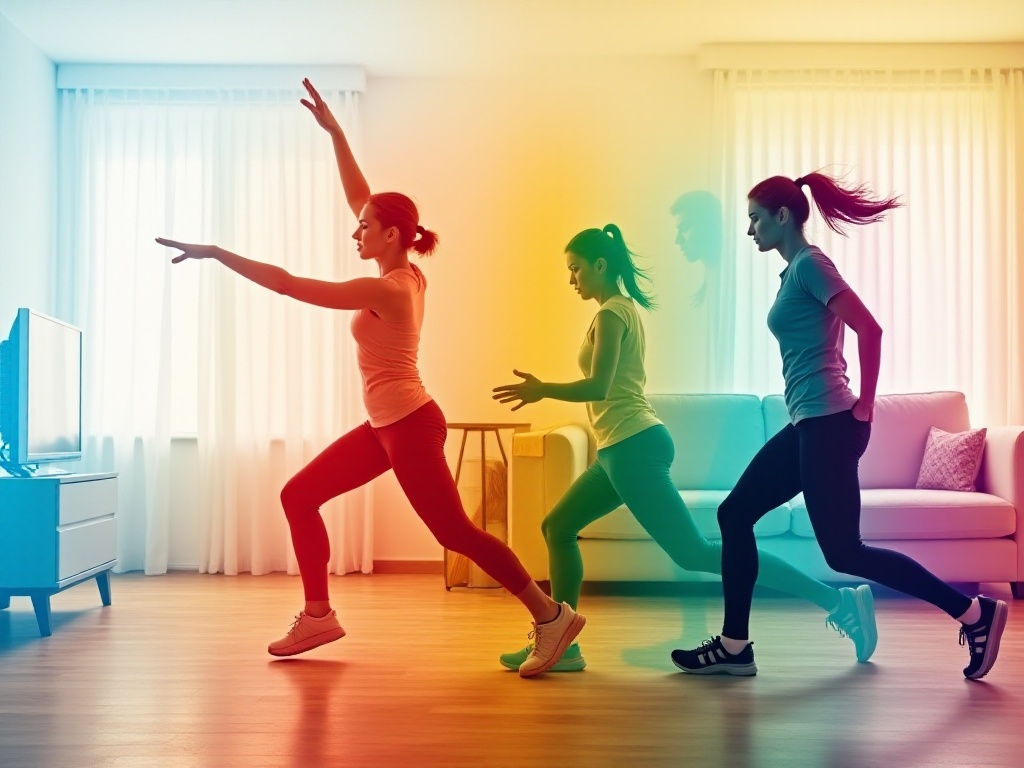Introduction
Recently, my social media has been flooded with fitness-related topics, with many friends asking me how to maintain a workout routine at home. Honestly, I completely understand their feelings! I remember when I first started working out at home, I faced many challenges: limited space, expensive professional equipment I couldn't afford, and irregular work and study schedules that often led to giving up halfway... However, after years of trial and error, I've finally found some methods and techniques that work for me. Today, I'd like to share these with you, hoping to help those who are also striving on their fitness journey!
Space Organization
When it comes to working out at home, many people's first reaction is: "My place is so small, I can barely turn around, how can I exercise?" Don't worry, let me share some good news: actually, just 2 square meters of space is enough! The key is how to cleverly plan and utilize this space.
I suggest first finding a relatively quiet area where you won't be disturbed. This area should ensure that you won't be interrupted by family members during exercise, and you won't disturb others. For example, I chose the spot near the window in my bedroom. It's perfect for morning workouts when there's plenty of sunlight, and the view outside makes exercising less monotonous. I laid down a professional yoga mat in this spot, choosing non-slip material for safer jumping exercises. Next to the mat, I placed a simple three-tier cabinet for storing workout equipment. The first layer holds frequently used small equipment like resistance bands and grip strengtheners; the second layer stores workout clothes and towels; and the third layer contains equipment that's used less frequently but occasionally needed. This storage method is both neat and practical, making it very convenient to access equipment.
When arranging the space, I paid special attention to lighting and ventilation. If possible, it's best to place a small fan near the workout area - you'll really need it during summer workouts. I also hung a full-length mirror on the wall so I can check if my form is correct. The mirror doesn't need to be too large, just big enough to see your overall movements. Additionally, I found that placing some plants in the workout area not only purifies the air but also adds vitality, making the exercise environment more comfortable.

Equipment Selection
When it comes to fitness equipment, many people might think it's a significant expense. But there's no need to worry! Let me share some money-saving yet super practical tips.
First, many common household items can be transformed into fitness equipment. For instance, water bottles make natural dumbbells. A 500ml bottle weighs about 0.5kg, a 1.5L bottle about 1.5kg, and a 2L bottle is 2kg. You can choose different bottle sizes based on your needs, and even adjust the weight by changing the amount of water. When I first started, I used two 2L bottles to train my biceps and triceps, and the results were really good!
Backpacks are also great helpers. Fill them with books, and they instantly become weight vests. Different book thicknesses can adjust the weight, perfect for various weighted exercises. Plus, books distribute weight evenly, avoiding unbalanced loading.
Household towels can also be put to good use. Fold a towel several times, and it becomes a resistance band. Though the resistance isn't as strong as professional bands, it's completely adequate for beginners. I often use towels for stretching exercises, especially for shoulders and back, with great results.
Regular dining chairs or stools can become training equipment. A sturdy chair can be used for push-ups, tricep dips, split squats, and more. However, be especially careful about safety when using chairs, ensuring they're stable enough, and preferably place non-slip pads under the chair legs.
Of course, as your fitness level improves, you might need some professional equipment. At this point, I suggest starting with some basic and practical gear. For example, a good yoga mat is essential as it protects your joints and prevents injury during exercise. A professional resistance band is also important, with different colors representing different resistance levels that can be chosen based on the training area and intensity.
If your budget allows, consider purchasing a pair of adjustable dumbbells. Though the initial investment is larger, a one-time purchase can meet long-term usage needs, and they're convenient to store. I currently use a pair of adjustable dumbbells that can be adjusted from 2.5kg to 24kg, basically covering all training needs.

Scientific Planning
When it comes to workout plans, this is quite a science. Many people ask me: "How long should I exercise each day? How intense should it be?" This really varies from person to person, but there's one eternal principle: gradual progression.
Let me share a beginner's plan that I've used. The first week focuses on adapting to the exercise rhythm, just stick to 10 minutes each day. These 10 minutes mainly consist of simple warm-up exercises like jogging in place, high knees, and jumping jacks. Don't think the short time means no results - the key is forming habits.
By the second week, we extend the time to 15 minutes and start incorporating some basic strength training. This includes classic moves like push-ups, squats, and planks. If you can't do standard forms at first, that's okay - start with modified versions. For example, wall push-ups or chair-assisted squats, then gradually transition to standard moves as strength improves.
The third week is a small turning point. We increase exercise time to 20 minutes and begin trying high-intensity interval training. Specifically, this means adding time concepts to basic moves, like 30 seconds of exercise followed by 30 seconds of rest. This training method not only improves cardiopulmonary function but also helps burn more fat.
By the fourth week, we adjust based on physical condition. Generally, you can extend the time to 25-30 minutes. You'll find that unconsciously, you can now do many moves that seemed difficult at first. For instance, you might have started with only 5 knee push-ups but can now do 15 standard push-ups.
When making plans, there are several key points to note. First, give your body adequate rest time - it's not recommended to do high-intensity training seven consecutive days. I typically schedule strength training on Monday, Wednesday, and Friday, cardio on Tuesday and Thursday, and use one weekend day for light stretching while completely resting the other day.
Second, pay attention to workout completeness. A complete workout should include warm-up, main training, and cool-down. While many people know about warm-up, the cool-down phase is often neglected. Actually, spending 5-10 minutes stretching after exercise not only helps muscle recovery but also prevents next-day soreness.
Finally, remember: consistency is key in exercise, not temporary intensity. I've seen too many people set extremely high goals at first, only to give up shortly after. Rather than setting an unattainable goal of "exercising two hours every day," it's better to start with 15 minutes daily and gradually build the exercise habit.
Time Management
"Too busy to exercise" is definitely one of the most common excuses. But honestly, the issue isn't whether you have time, but how to arrange it reasonably. After much exploration, I've summarized some particularly practical time management tips.
First, break exercise time into multiple short segments. For example, you can do calf raises while brushing your teeth - this exercise not only trains calf muscles but also improves balance. Brushing typically takes 2-3 minutes, plenty of time for 20-30 calf raises.
Watching TV at noon is also a good opportunity. Commercial breaks usually last 3-5 minutes - rather than mindlessly scrolling through your phone, you could do some push-ups. If standard push-ups are too difficult, start with knee push-ups. During one episode, you can easily complete 20-30 push-ups.
You can also squeeze in exercise while cooking. For instance, while waiting for water to boil, you can do a set of squats leaning against the kitchen counter. This not only doesn't interfere with cooking but effectively uses this "dead time." Plus, the heat generated from exercise will increase your appetite - why not?
Even in the office, there are many exercise opportunities. Like taking extra steps when getting water, choosing a farther bathroom, or finding a quiet corner during lunch break for some stretching. These seemingly small amounts of exercise add up significantly.
My experience is that rather than squeezing out one large block of exercise time, it's better to integrate exercise into daily life. This is not only easier to maintain but also puts less pressure on yourself. Plus, this method is particularly suitable for office workers, not affecting normal work rhythm.

Maintaining Motivation
Honestly, starting exercise isn't difficult - persistence is the challenge. I've seen too many people show initial enthusiasm but give up after a while. So how to maintain exercise motivation is a particularly important topic.
First, setting small goals and rewards for yourself is important. These goals should be specific, measurable, and achievable. For example, the first week's goal might be doing 10 standard squats, rewarding yourself with a healthy meal upon completion. Note that it should be healthy food, not junk food! I usually choose high-protein, low-fat foods like chicken breast salad or salmon.
Monthly goals are also necessary. For instance, completing a 30-day training plan, rewarding yourself with new exercise equipment upon achievement. It could be a new resistance band or a nice workout outfit. This equipment not only improves training effectiveness but also adds ceremony to the exercise.
As for long-term goals, they can be slightly more challenging. Like losing 5kg of excess weight in three months, or being able to do 20 standard push-ups. After achieving these goals, you can reward yourself with a short trip. Don't forget to maintain exercise habits during travel - this way you can relax while maintaining training rhythm.
Recording daily exercise is also important. I now use a fitness app on my phone to record training duration, sets of exercises, weight changes, etc. Sometimes looking back at previous records and seeing your progress really gives a sense of achievement. If you find apps too troublesome, using pen and paper is also a good choice. The key is developing the habit of recording, so you can visually see your progress.
Finding like-minded companions is also a good way to maintain motivation. They can be real-life friends or online fitness groups. Everyone supervises and encourages each other, discussing solutions when problems arise. I joined an online exercise check-in group, seeing others' persistence in the group daily gives me more motivation.

Safety Guidelines
When it comes to exercise safety, this is absolutely crucial. I've seen too many people get injured due to ignoring safety issues, forcing them to interrupt their training. So here, I want to particularly emphasize safety precautions.
First is warm-up, this step absolutely cannot be skipped! No matter what exercise you plan to do, spend 5-10 minutes doing a thorough warm-up. The purpose of warming up is to increase body temperature, enhance muscle flexibility, and reduce the risk of sports injuries. My warm-up usually includes:
- Neck rotations: 15-20 times in each direction, movements should be slow, not too forceful
- Arm circles: 20 times forward and backward, gradually increasing amplitude
- Waist rotations: 20 times left and right, focus on controlling the core
- Hip joint rotations: 15-20 times in each direction, can hold onto a wall for support
- Ankle rotations: 10-15 times in each direction for each foot
- Full-body jump rope or jogging in place: 3-5 minutes, get the body fully warmed up
Second is the hydration issue. Many people know to hydrate during exercise, but the timing and method of hydration are also important. My suggestions are:
30 minutes before exercise: Drink 200-300ml water, keeping the body well-hydrated During exercise: Take small sips every 15-20 minutes, 50-100ml each time After exercise: Replenish 300-500ml water based on sweat loss, can add appropriate electrolytes
I'm used to preparing a large water bottle, about 750ml capacity. The bottle should preferably have measurements, making it easier to control water intake. Also, recommend choosing a sports water bottle with leak-proof design to prevent spills during exercise.
Proper form is also a crucial safety guarantee. Each movement must be done strictly according to correct form - better to do fewer repetitions than sacrifice quality for quantity. For example, with squats, make sure to:
- Knees don't extend past toes
- Push hips back
- Keep back straight
- Engage core
- Coordinate breathing with movement
If any movement feels particularly strenuous or uncomfortable, stop immediately. Exercise isn't about pushing to exhaustion - learn to listen to your body's signals.
Venue safety is also important. Keep the exercise area dry and clean, with no sharp objects around. If using chairs or other furniture, ensure they're stable enough. The floor should preferably have non-slip mats, especially when doing jumping movements.

Concluding Thoughts
Looking back on these years of fitness experience, my biggest realization is: exercise isn't actually that difficult - the key is finding what works for you. Everyone has different physiques, life rhythms, and preferences, so don't blindly follow others' training methods. Finding suitable exercise methods for yourself is what truly turns exercise into a habit.
Remember, everyone starts from zero. Just like how I couldn't even do a proper squat at first, but now can easily complete various training exercises. What's important isn't where you start, but having the courage to take the first step and then persist.
I hope through sharing this article, I can help those who are working hard on their fitness journey. Let's make exercise the most natural part of life together, enjoying the happiness and changes that exercise brings!







